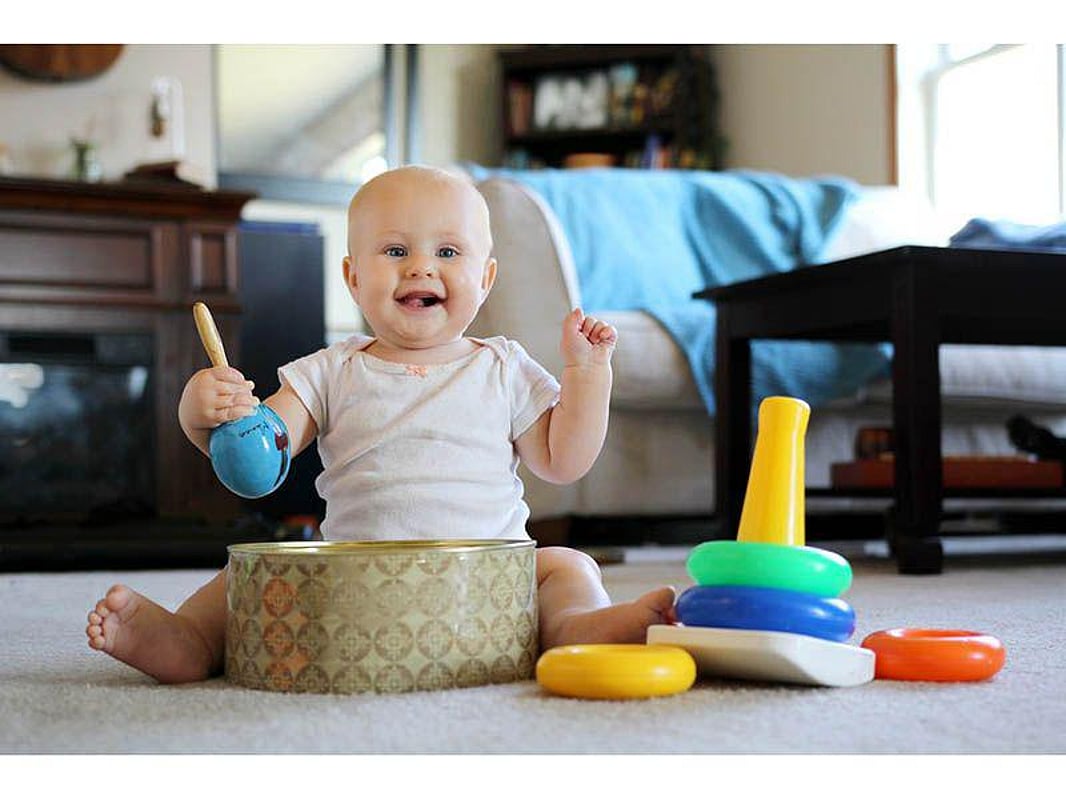Month 08 Physical Development

By now, your baby is moving towards all sorts of fun and mischief. Different babies have different methods for getting around. Some scoot on their bellies, some use their arms to push themselves backwards, and some have already mastered the classic forward crawl. However your baby decides to crawl, she needs your help to polish her skills, have fun, and stay safe.
Watch her face as she works on her moves. At first, she'll probably be frustrated with her progress. When she first starts to crawl, her tummy may drag on the ground like an anchor. Encourage her to move by placing exciting objects within crawling distance. At this age, she really enjoys exploring her world, so she's highly motivated to improve her technique. When she finally gets that tummy off the ground or makes any other breakthrough, give her plenty of praise. She'll be proud of herself, and she wants you to be proud, too.
If she's already a master crawler, you can help her find new challenges. See if she can crawl over a cushion or a sturdy box. You can even lie down on the floor and make yourself part of the obstacle course. Never leave your child alone when she's awake and active. Especially don't let her crawl over obstacles when you aren't around. She could fall and hurt herself.
At this age, your baby might be able to go to straight from crawling to a sitting position. It may seem like a minor move, but it's a big deal for her. She'll be more independent during play, which means less frustration for her and less work for you.
By now, your baby has probably figured out how to pull herself into a standing position. However, she might not know how to get down. If she seems "stuck," help her bend her knees to slowly lower herself to the ground. You may also have to help her get her footing. For some reason, many first-time standers will stay on their tiptoes and keep their feet pointed inwards. If your baby does this, you can gently put her heels on the floor and point her feet outwards. She'll quickly realize that this stance gives her much better support.
Once she gets her balance, watch out. She'll be able to stand in one place for as long as 10 minutes, and it won't be long before she's cruising along the couch, the coffee table, and anything else handy. You'll have to make sure that every piece of furniture within reach is sturdy enough to support your little explorer. A wobbly bookcase could lead to disaster.
When she's not busy moving around the room, she'll enjoy playing with toys of all sorts of textures, shapes, and sizes. Small objects may become especially appealing. Around this age, she'll learn how to make her thumb and forefinger work together, a maneuver that makes it easy to pick up all sorts of small things. Of course, you don't want her to practice her skills on coins or buttons or anything else that doesn't belong in her mouth. Instead, put her in her highchair and give her a chance to play with a pile of cooked, cooled spaghetti or some O-shaped cereal. She'll also enjoy sitting on the ground and picking at individual blades of grass, but you should watch her closely to make sure she doesn't do too much grazing.
Her tendency to throw and drop things may start turning into an obsession. She'll love everything about it: the sight of the object flying through the air, the sound it makes when it lands, and the look on your face. Now that she can let go of things on purpose, she'll start passing toys from one hand to the other and back again. This is surprisingly big fun, and she'll do it for as long as 20 minutes without taking a break.
At her age, it doesn't take much to have a good time. And the more time she spends showing off her new skills, the more time you'll have to relax and enjoy the show.
References
Sears, William and Martha. The Baby Book: Everything You Need to Know About Your Baby From Birth to Age Two. Little, Brown and Company.
American Academy of Pediatrics. Caring for Your Baby and Young Child: Birth to Age Five. Bantam Books.
University of Florida, Department of Family, Youth, and Community Sciences. How I Grow: Months Seven and Eight. http://edis.ifas.ufl.edu/fy635
Zero to Three, The American Academy of Pediatrics. Healthy Minds: Nurturing Your Child's Development from 6 to 9 Months. http://main.zerotothree.org/site/DocServer/6-9months.pdf
Related Posts
La EPA asigna 58 millones para ayudar a las escuelas y guarderías a eliminar el plomo del agua potable
MARTES, 25 de julio de 2023 (HealthDay News) -- El lunes, la administración de...
Supply Chain Issues Bring Shortages of Drugs, Devices to U.S. Hospitals
THURSDAY, Nov. 4, 2021 (HealthDay News) -- The word went out late last month...
13 Percent of Patients With Anti-NMDA Receptor Encephalitis Have Suicidal Thoughts
THURSDAY, Feb. 23, 2023 (HealthDay News) -- Thirteen percent of patients with...
